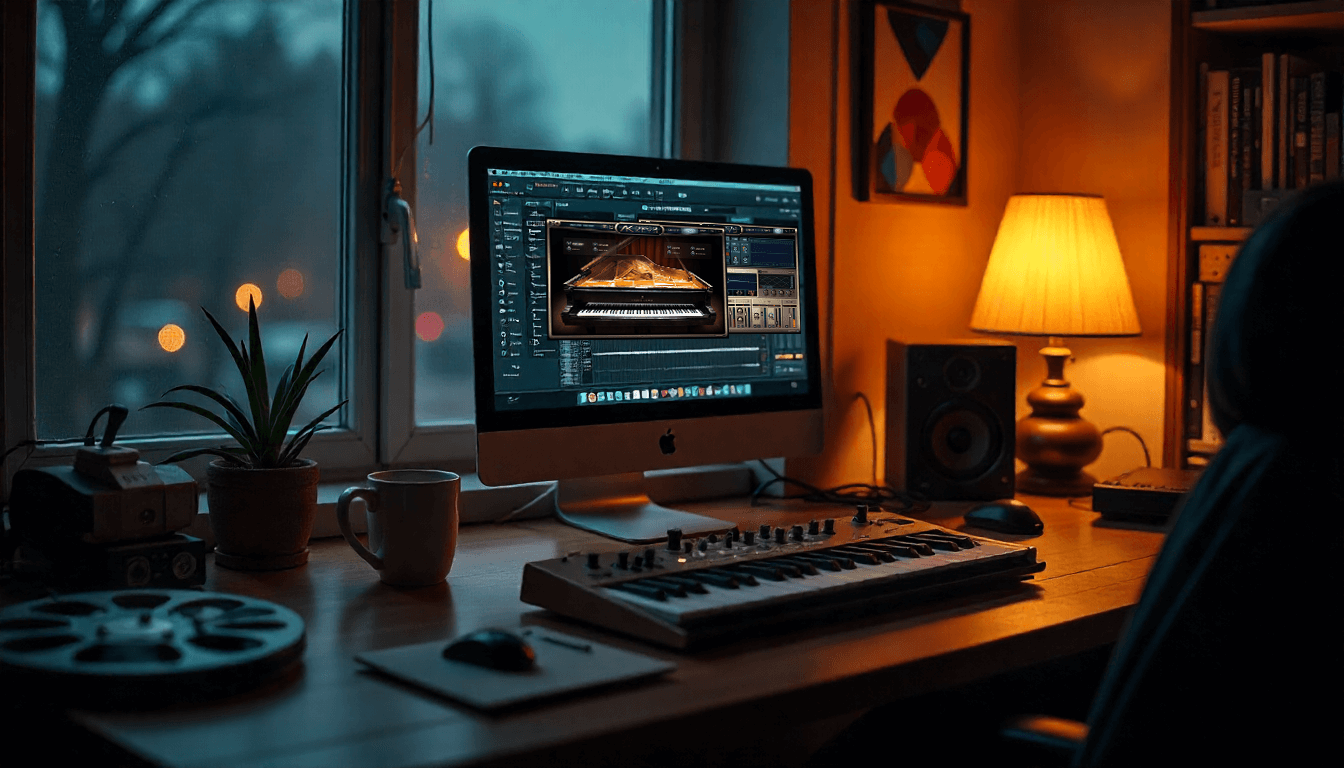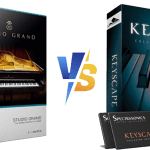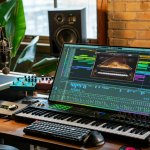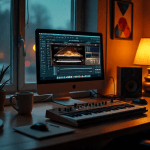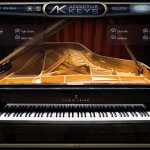Lo-Fi, Jazz & Noir
You don’t need a dusty upright in a basement or a 1950s recording studio to get that classic piano sound. These days, a lot of the warmth, grit, and mood we associate with vintage piano sounds can be recreated right inside your DAW—especially if you’re using Addictive Keys: Studio Grand.
If you’d like a full breakdown of its sound quality, features, and how it stacks up against plugins like Pianoteq and Keyscape, don’t miss my Addictive Keys Studio Grand Review.
Whether you’re scoring a rainy-night scene, laying down chords for a chill beat, or channeling your inner Bill Evans, Addictive Keys gives you plenty of room to shape your piano tone with mic blends, subtle detuning, analog-style noise, and reverb that feels lived-in.
👉 Don’t own Addictive Keys yet?
Grab Studio Grand here so you can follow along as we explore its sound and features.
Why Bother with “Old-Sounding” Pianos?
Let’s be honest: a perfectly clean, modern piano can feel a little sterile. Vintage tones—whether slightly out of tune, wrapped in tape hiss, or drenched in plate reverb—carry emotional weight. They feel human.
- Lo-Fi: Think late-night study sessions, rain on the window, and slightly warped records. It’s cozy, imperfect, and nostalgic.
- Jazz: Intimate, harmonically rich, and full of swing. You can almost smell the cigarette smoke and hear the clink of glasses.
- Noir: Dark, sparse, and tense. Every note feels like it’s hiding a secret.
Back in the day, engineers like Rudy Van Gelder got these sounds with ribbon mics, tube preamps, and analog tape. Today, vintage piano sounds in Addictive Keys let you fake it convincingly—no vintage gear required.
Quick Setup in Addictive Keys
Before diving into styles, get familiar with your toolkit in Addictive Keys Studio Grand:
- Mic perspectives: Mix Close, Overhead, and Room mics to control how “present” or “distant” the piano feels.
- Tune FX: Adjust tuning, stretch, and dissonance for that slightly-worn piano character.
- Noise: Add tape hiss or vinyl crackle at low levels for texture.
- Channel Strip: Tweak EQ, add subtle distortion or chorus, and dial in warmth.
- Delerb: A great plate and room reverb engine—key for vintage ambience.
Once you’ve got that down, you can start shaping your vintage piano sounds in Addictive Keys for each genre.
Creating Authentic Vintage Piano Sounds in Addictive Keys
Lo-Fi Piano: Cozy, Cracked, and Slightly Off
Lo-Fi piano isn’t about precision—it’s about vibe. Slight detuning, background noise, and soft, jazzy chords sell the mood.
In Addictive Keys:
- Mics: Start with the Close Tube mic for warmth; add a touch of Room for depth.
- Tune FX: Push Dissonance to +1.5–2 dB for gentle detuning.
- Noise: Enable Tape 7.5 ips or Vinyl around -60 dB—just enough to hear it in the quiet moments.
- Play: Use extended chords (like Cmaj7, Dm9, G13) and leave space between notes. Don’t quantize too hard—let it breathe.
DAW Chain (optional but helpful):
- Light tape emulation (try iZotope Vinyl or RC-20)
- High-pass below 100 Hz
- Gentle boost around 250–400 Hz for body, slight dip around 1–2 kHz to soften harshness
- Short plate or room reverb (1–1.5 sec decay)
- Light compression (2:1, slow attack) to even things out without squashing
Try this progression in C minor:
Cm7 – Fm7 – D♭maj7 – G7
Loop it slowly, add a swung drum loop, and you’ve got instant late-night vibes.
Vintage Jazz Piano: Warm, Present, and Swinging
This is the sound of Blue Note records—clear but never clinical, rich but never muddy.
In Addictive Keys:
- Mics: Close or Close + Overhead for that “player’s perspective” feel.
- Velocity Curve: Slightly uneven to mimic an older action—some notes respond softer than others.
- EQ: High-pass at 50 Hz, low-pass at 12 kHz, and a gentle bump around 4–5 kHz for articulation (the “Van Gelder sparkle”).
- Reverb: Delerb Plate, 1.5–2.5 sec decay, no pre-delay—just enough to place it in a small club.
DAW Chain:
- Tape saturation at 15 ips (subtle!)
- Light compression (2–3:1, 2–3 dB GR)
- Keep it mostly mono or narrow stereo—old jazz recordings rarely panned wide
Classic jazz turnaround in F:
Dm7 – G7 – Cmaj7 – A7 → then Dm7 – G7 – Cmaj7 – E7 – Am7 – D7 – Gmaj7 – C7
Play it with swing, add a walking bass, and you’re halfway to a smoke-filled basement in 1959.
Noir Piano: Moody, Sparse, and Shadowy
Noir piano is less about chords and more about atmosphere. Think Chinatown or Blade Runner—minimal, haunting, and loaded with tension.
In Addictive Keys:
- Mics: Blend Close and Room—you want intimacy but also a sense of space.
- Filter Envelope: Roll off highs slightly for a darker tone.
- Noise: Add pedal squeak or low-level room tone for realism.
- EQ: Cut below 120 Hz to avoid muddiness; subtle lift at 2.5–3.5 kHz so notes cut through the gloom.
- Reverb: Delerb Plate with 150–250 ms pre-delay and short decay (1–1.2 sec)—creates distance without washing out the notes.
- Modulation: A whisper of chorus (3–5%) adds a ghostly shimmer.
DAW Chain:
- Tube or tape saturation for warmth
- Very little reverb beyond what’s in Addictive Keys—keep it dry and confined, like a piano in an empty bar at 3 a.m.
Noir-friendly progression in E minor:
Em – B7 – Em – Am → then Em – C – G – D/F#
Play it slowly, leave long silences, and lean into dissonance (try adding a G# over Em for tension).
Bonus Tips for Going Deeper
- Stretch Tuning: Turn the Stretch knob slightly positive—it mimics how real pianos are tuned (bass slightly flat, treble slightly sharp).
- Layer Wisely: Add distant rain, vinyl crackle, or a muted trumpet sample in the background for cinematic depth—but keep it subtle.
- Mic Phase: When blending mics, flip polarity on one channel if the sound gets thin. Phase issues can kill low-end warmth.
- Start from Presets: Load an “ExploreMap” like Jazz Club or Lo-Fi Keys, then tweak from there—it’s faster than building from scratch.
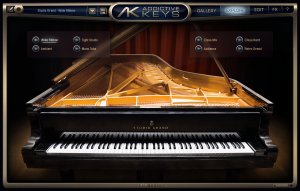
🎹 Why I Recommend Addictive Keys
After testing countless piano VSTs, I keep coming back to Studio Grand:
✅ Realistic, expressive tones
✅ Built-in reverb, EQ, and tape-style noise
✅ Affordable compared to competitors
👉 Click here to check out Addictive Keys Studio Grand
Final Thought
Vintage piano isn’t about chasing perfection—it’s about leaning into character. A little noise, a slightly detuned note, or a room that breathes can make your track feel lived-in and emotionally resonant.
With Addictive Keys, you’ve got everything you need to craft compelling vintage piano sounds in Addictive Keys—mic blends for space, Tune FX for imperfection, and Delerb for mood. Pair it with the right chords, and you’re not just making music—you’re setting a scene.
Now go make something that sounds like it’s been sitting in a basement for 50 years… in the best way possible.

